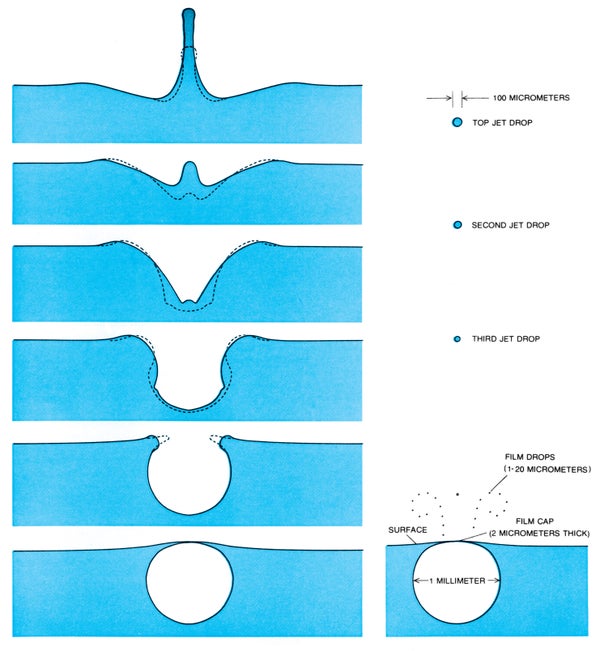May 2024: Science History from 50, 100 and 150 Years Ago
Pavlov’s dogs; Mercury’s dark side

1974, Bursting Bubbles: “Some 3 or 4 percent of the sea surface is covered with bubbles at any moment. They provide the chief mechanism for injecting into the atmosphere substances in the top micrometer of the ocean [such as sodium and potassium ions, proteins and plankton]. The drawings show (from bottom to top) how a collapsing bubble projects a high-velocity jet of liquid into the air.”
Scientific American, Vol. 230, No. 5; May 1974
1974
Mercury’s dark side
“On March 29, Mariner 10 transmitted revelatory information about Mercury. The spacecraft’s pictures showed that Mercury strongly resembles the Earth’s moon in that its surface is much cratered, little eroded and has large, smooth areas, or ‘seas.’ Moreover, data on the infrared radiation from the planet’s dark side and illuminated side indicate that its surface is much like the moon’s: low in density and therefore probably rich in silicon and poor in iron. The overall mass of Mercury, however, indicates that the density is 5.5 grams per cubic centimeter, compared with 3.3 grams for the moon. Its core must therefore consist of heavy material, probably rich in iron and poor in silicon. Thus Mercury, unlike the moon and like the Earth, is a highly differentiated body.”
On supporting science journalism
If you’re enjoying this article, consider supporting our award-winning journalism by subscribing. By purchasing a subscription you are helping to ensure the future of impactful stories about the discoveries and ideas shaping our world today.
1924
Hydrogen Bomb, Perhaps
“The atomic weight of hydrogen is not exactly 1.0 but by careful measurement is found to be 1.0077. In this slight discrepancy an immense store of possible energy is indicated, which someday, when we have learned how, may become accessible for good or ill. When hydrogen is packed into helium, [a small portion disappears]. The 1.0077 becomes 1.0. Although the disappearing fraction is small, the result would put all our other sources of energy to shame. The packing of atoms into atoms is a violent kind of phenomenon. And the undoing of atoms into non-circulating ether is the most violent of all.”
Pavlov’s Dogs
“The basis of nervous activity is formed by so-called reflexes and instincts. For example, food stimulates the food reflex, which in animals consists of certain movements and secretions. But if some indifferent agent is presented many times with the feeding, it begins to stimulate the food reaction. Thus, if we produce some distinct musical sound and always at the same time feed a dog, after a while this sound, used alone, will produce the same food reaction as the food itself. In this way, some reflexes are acquired. The inborn reflexes we call unconditioned, and the acquired reflexes we call conditioned. —I. P. Pawlow of Petrograd [Ivan Petrovich Pavlov of St. Petersburg, Russia]”
1874
Mountains Hidden by Desert
“Among the geological deductions of the Wheeler expedition are the following: All that portion of the U.S. west of the plains is characterized by corrugation, that is, the geological formations once horizontal have been bent and broken and thrown into ridges so as to produce a mountainous country. The ridges vary greatly but agree in general northerly trend. In the lower parts of this great mountain system, the slow but indefatigable agencies of rain and stream have accumulated so great an amount of detritus that the valleys are clogged and the mountains are nearly or quite buried. In this way have been produced the great desert plains of Utah, Arizona and Southern California, from the surface of which a few half-sunken peaks jut forth.”
When the Skunk Bites
“While it is apparently difficult to add anything to the odium which is already attached to the common skunk, Rev. Horace C. Hovey brings forward proof that the animal is as dangerous as it is disagreeable. In a paper, he considers that a new disease has been discovered, to which he gives the name rabies mephitica, transmitted by the bite of the skunk. Mr. Hovey gives a large number of instances of people and animals dying from this cause in fearful convulsions. In view of the great number of skunks in portions of the country, it would appear that a more extended investigation into this disease is of much importance.”
Killer Mollusk
“The Jardin d’Acclimatation of Paris was recently presented with a medusan polypus, a rare species of mollusk, which was placed in a tank of water with similar organisms. To the surprise of the curators, it was found that after twenty-four hours the creature had killed every other occupant of the vessel. Analysis of the water proved that the liquid was water no longer, but vinegar. The polypus, it appeared, has the property of changing water into a strong acetic solution. The animal, it is said, produces alcohol, which it transforms into vinegar.”


